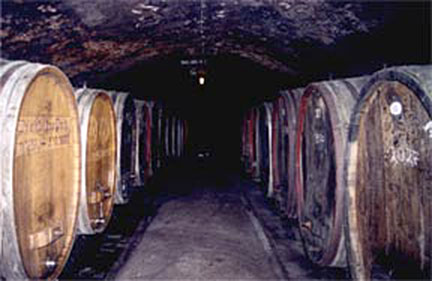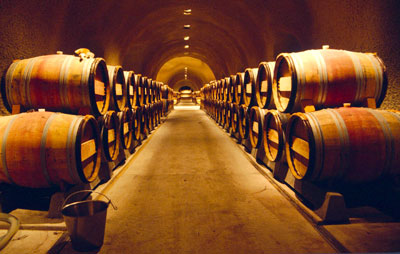Most of the world’s fine wines are aged in wooden casks or barrels. While there are other determinants of a wine’s quality, such as the vineyard and the skill of the winemaker, the period of up to several years in wooden “cooperage” or barrels has a significant influence on the ultimate character of the wine.

Wine is aged in wooden barrels, as opposed to stainless steel tanks, to enhance the flavor, aroma and complexity of the wine through the extraction of substances from the wood into the wine, and to allow air (oxygen) to come in contact with the wine to allow a slow, gradual oxidation process. The influence of barrel aging on the character of a wine varies based on several factors, including the type of wood used, the age of the barrel, the techniques used to make the barrel, barrel size, thickness of the staves (the individual strips of wood which form the barrel), cellar humidity and the length of aging.
Historically, the type of wood the winemaker chose was a question of tradition, wine variety, economics and personal taste. Redwood was commonly used in the construction of puncheons or uprights many times larger than the traditional 60-gallon oak barrel. But it is no longer used because it is too rigid to allow bending of the staves and it imparts a yellow tint to the wine. Chestnut, although high in tannin, is too porous and must be coated with paraffin to prevent excessive wine loss through evaporation.
Oak, on the other hand, due to its strength, workability and lack of undesirable flavor or color extractives, is used almost exclusively in the barrel aging of fine wines. Oak has a relatively tight grain which permits a more gradual extraction of wood flavors and minimizes wine loss through evaporation. It also is resilient, enabling staves to be bent without breaking and unlike other hardwoods such as apple or cherry, has a neutral wood smell. Oak is high in tannin, which in proper amounts is an important flavor component as well as allowing red wines to age by gobbling up oxygen, which would otherwise spoil the wine.
Coopers demand higher quality and pay higher prices for oak than do furniture manufacturers. As a result, oak barrels are expensive. The world’s great wines command a high enough price and have sufficient aging potential to justify the expense of oak barrels. However, they are not necessarily appropriate for all grape varieties. Less expensive and lighter, more delicate wines such as Riesling, Chenin blanc, Gewurztraminer, some Sauvignon blanc and certain red grape varieties such as Gamay (Beaujolais) are bottled and intended to be consumed when still young and fruity. Oak would mask their fruit aromas and would certainly not be justified in terms of cost. Instead, these wines are aged in stainless steel tanks under cool temperatures for a few months to preserve their varietal character.
There is a difference of opinion between the majority of winemakers who insist on French oak and the growing minority using American oak. In the United States, white oak, grown in Virginia, Missouri, Kentucky, Oregon, and Ohio, is the species used for barrels. It is preferred over red and black oak due to its tighter grain which minimizes evaporation of wine from the barrel and its resistance to shrinkage after wine is removed, an important feature in preventing wine from leaking out of a newly-filled barrel, and its high tannin content.

French white oak is harvested from several different forests in France. The most common forests are Limousin, Alliers, Vosges, Troncais and Nevers, each producing oak that imparts slightly different nuances of flavor to the wine. The tightness of the grain, which determines the rate of extraction of these flavors, also varies among forests. Winemakers typically use a blend of barrels from different forests to take advantage of the unique characteristics of each. This notion of regional character does not exist with American oak. Winemakers using American oak are more concerned with the reputation of the cooper than exactly which state the oak was grown in.
Beyond the variation among forests, the character of oak can vary among trees within a given forest due to factors such as growth conditions and age. The traditional 60-gallon oak barrel contains approximately 3l staves from a variety of trees. A cooper’s reputation is established on the basis of his ability to make a uniform product from year to year. While winemakers expect variation in grape quality from vintage to vintage, consistency in the new barrels they purchase from one year to the next is critical.
As wineries have sought to lower production costs, the demand for American oak has increased dramatically. More winemakers have substituted American oak barrels costing about $200 each for French oak barrels costing over $500 each. This trend has prompted renewed scrutiny of the differences between American and French oak.
While both American and French oak contribute tannin and aroma, French oak contains more tannins and flavor components and has a less obviously “oaky” flavor and smell than American oak. American oak has a more aggressive mouthfeel and immediately apparent aroma. American oak contains more vanillin (vanilla aroma) and more odorous compounds.
It was thought American oak’s somewhat harsh, raw character ruled out its use for white wine and made it desirable for aging powerful, robust red wines such as Zinfandel, Cabernet Sauvignon, Merlot and Petite Syrah. But coopers in California have been successful in reducing the undesirable characteristics of American oak by applying production techniques traditionally used by French coopers. For example, the newly cut stave wood is stacked outside to air-dry for a minimum of l8 months instead of the more expedient kiln or oven drying. Air-drying exposes the wood to periods of rain and drying which leach out excessive harshness while retaining desirable components such as vanillin, 70% of which is lost during artificial drying. And “toasting” of the barrels is carried out more slowly over a lower heat, allowing a deeper penetration of the flame. In the past, American oak barrels were flash-fired, resulting in a heavy char suitable for aging bourbon.
Despite the progress in making American oak barrels more appealing, some winemakers remain adamantly opposed to its use in any form, particularly for white wines. “I wouldn’t let an American oak barrel near my Chardonnay. I am trying to make a more delicate, refined style of Chardonnay and I feel American oak would overpower the nuances that I want to achieve,” comments Bill Hunter, winemaker at Hunter Cellars in Sebastopol.

Robert deLeuze, winemaker at ZD Winery in Napa, who uses l00% American oak in his Chardonnay remarks, “In cooking, you use different spices depending on what you are making and what spices you like. The same is true of oak in winemaking. For the rich, powerful style of Chardonnay we’re making, American oak gives us what we want. If American oak has gotten a bad rap it could be because the low price makes people think it is low quality before even trying it. In fact, American barrels in the past may not have been suited to wine. They were originally air-dried for one year and given a heavy char to age whiskey in. As such, they were inappropriate for wine storage.”
Dick Steltzner of Steltzner Vineyards in Napa defends his use of French oak in terms of its role in aging. “American oak flavors are flashier and more up front and fade after a few years instead of developing like French oak.” Referring to the new developments in American oak production Steltzner feels that air-drying may leach out excessive tannins, but does not change the nature of the extract.
While the majority of winemakers side with Steltzner, several producers including Silver Oak, Ridge and Beaulieu Vineyard (Georges de Latour) use l00% American oak for aging their red wines. The late Justin Meyer, the former owner and winemaker of Silver Oak Vineyards said, “Originally, we experimented by putting our wine in different oaks and tasted the results blind. We preferred the American oak. Every winemaker looks for something different. If you conducted an experiment and five winemakers tasted the results, you would get five different responses. There is no right or wrong.”
Paul Draper, Winemaker at Ridge Vineyards in Cupertino, uses l00% American oak for aging his Zinfandel, Petite Syrah and Cabernet Sauvignon (with the exception of his Montebello Cabernet Sauvignon, which is 50% American oak). “When we started making wine in l969 we were California chauvinists, we didn’t want to make a California Burgundy or California Bordeaux. We liked the wines we made with American oak. At that time a French oak barrel cost $59 versus $35 for an American oak barrel so the economic motivation to use American oak wasn’t as great as it is today.”
The debate over French versus American oak is a lively one; it would be an oversimplification, however, to limit the oak question to the choice between American and French oak. Other factors, such as the cooper, toast levels, grain, cellar conditions and length of aging all have an important influence on the wine.
—Wine & Vines, November, 1992